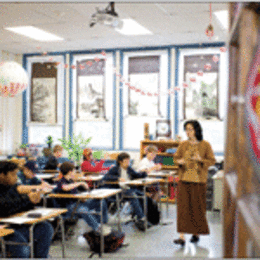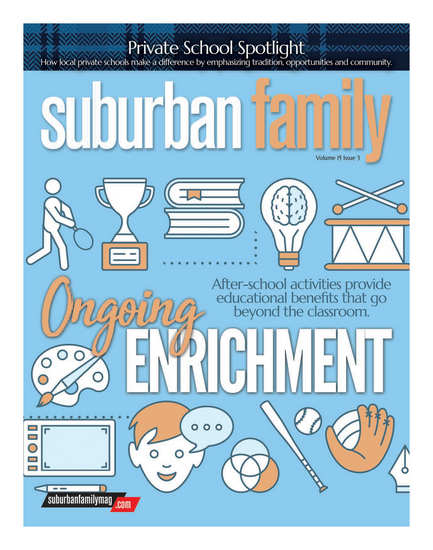
Q: If South Jersey’s steep property taxes cover the cost of public education, why do some parents still choose to pay for pricey private schools?
A: Read on…
In a well-appointed classroom in Moorestown, 16 sixth-graders sit around their teacher discussing Quaker values and rules. Words such as “simplicity,” “peace,” “integrity,” and “critical thinking” collect on the chalkboard as they consider how these concepts relate to real life. Among these 16 ’tweens, few—if any—are practicing Quakers. In fact, only 3 percent of all Moorestown Friends students are Quakers. Still, these religious values, woven throughout lesson plans, are part of what compels many families to pay between $15,100 and $22,350 to enroll their children at this private school. “At end of the day, kids spend so much time at school that we wanted to choose a school that fit our family values,” explains Moorestown resident Mike Paznokas, whose son Mikey is a second-grader. “The ethics in the classroom, the whole philosophy and values, they’re a big part of it for us.”
It’s a huge commitment. Families that choose private education not only pay school tuition but also, through the nation’s highest property taxes, support the public school systems in their municipalities. The average tax bill in the Garden State topped more than $7,000 in 2009, but is higher in places like Cherry Hill, known nationally for its high-performing schools, where the average home assessed at $140,000 costs its owner $8,254.40 in annual property taxes. Typically, around half of all property taxes collected in the state go toward education.
The health of the non-public high schools and primary schools in South Jersey is a mixed picture. Although figures are not available for South Jersey alone, enrollment in non-public schools state-wide slid by more than 29,000 as the recession took hold, from 190,000 in 2004 to 160,000 in 2009, according to a recent state report on non-public schools. Contributing to the decline: the loss of approximately 2,000 students from local Catholic elementary schools when the Camden Diocese closed 18 elementary schools in 2007.
In general, enrollments remain slightly down in comparison to last year, according to both the Camden Diocese and the Association of Delaware Valley Independent Schools (ADVIS). Yet some South Jersey private schools are actually more in demand. At St. Paul VI High School in Haddonfield, this year’s enrollment is up 24 students to 1,233. Holy Cross High School in Delran saw a slight increase in its incoming freshman class, and at Moorestown Friends, spokes?man Mike Schlotterbeck says there are waiting lists at seven grade levels.
Reasons for going
Given the fact that South Jersey’s private schools vary greatly in mission, it’s natural that families have different reasons for choosing them, even with access to the great public schools they’ve already paid for. For some, it’s about family tradition, fierce loyalty to their alma mater and the desire to give their children the same opportunities they had growing up. For others, finding a school to accommodate special learning needs is paramount. To wit, the Orchard Friends School in Riverton, Burlington County, is a private pre-school-through-eighth-grade building that solely enrolls children with language-based difficulties.
Often times, religious values are a driving factor. Still others believe the experience will increase their children’s chances of being accepted into selective colleges while others see advantages in smaller schools and class sizes—hallmarks of many private schools. In a smaller school, students typically have more opportunities to play sports, try out new activities and take on leadership roles, says Barbara Kraus-Blackney, executive director of ADVIS.
Even in larger private schools like Gloucester Catholic High School, with 672 students, supporters cite a family-like, caring atmosphere among the top reasons to enroll in the Gloucester City-based school. “Gloucester Catholic really is just like one huge family,” says Jane “Neen” Raspa, mother of two graduates and one current junior. “You walk in and it’s so true: everybody knows your name. My kids have the same teachers that I had. My classmates became their teachers.”
“Children do not get lost in the system in independent private schools,” says Kraus-Blackney, noting such schools are pricy—typically costing between $16,850 to $21,190 as some 23.5 percent of students receive some level of financial aid. New this year, she says, are families who may not have considered private school in the past now choosing them as a result of the deep cuts sustained by New Jersey public schools this year. “Certainly we have our budget concerns too,” Kraus-Blackney adds. “But even if enrollment was tighter, we wouldn’t cut out core subjects because we think they are part of what is so special about our schools.”
Starting young
Additionally, many families choose private programs in wealthier communities where public kindergarten is typically offered only as a half-day option. Leigh Costello, whose 5-year-old son Colin attends Resurrection Catholic School in Cherry Hill, says the academics are solid and likes that the kindergarten is a full-day program. “It would cost me the same for an afterschool program as the tuition it costs me to send him to [Resurrection’s] all-day kindergarten,” explains Costello, who works fulltime as a parole officer. While some of the families end up enrolling their children in public school for first grade, like Costello plans to do with Colin, others will be so impressed with the private school that they will stick with it.
The Camden Diocese has stepped up its game to compete with the area’s public schools. Nicholas Regina, the Diocese’s executive director, says that every elementary school in the Diocese now employs a professional charged with recruitment and retention. Since new programs were put in place, including a day when kindergarteners spend time in the first grade, the Diocesan schools have retained some 90 percent of their kindergarten classes—far better than years past, says Regina.
Cutbacks affecting decisions
While some families have private schools in their bloodline, others come to it as a process. When Robyn Greenberg moved to Voorhees, she had no reason to think she wouldn’t be sending her young children to the public schools. But after seeing how her oldest daughter Sabrina thrived in the smaller environment at her private Jewish preschool and kindergarten, Greenberg chose Kellman Brown Academy, a Jewish day school in Voorhees. It turned out to be an amazing fit, says Greenberg. Beyond the academics, she is overjoyed by the school’s approach to teaching Judaism and the importance of helping others.
“I felt Kellman could cater to my child and her needs, and now that she’s there, we love the mensch-like behavior,” says Greenberg. While she had intended to make elementary school choices for her younger children on a kid-by-kid basis, the recent cuts to public school have been unsettling. More likely than not, she says, she will apply to Kellman for the younger two as well. “The cuts to Voorhees schools happened after our decision but, I’ll tell you, it does reinforce our decision,” she adds
How much are we spending?
Total cost per pupil/Average property tax bill
State Average: $13,860
Washington Township: $13,515/$6,342.89
Evesham Township: $13,191/$6,601.59
Moorestown: $13,104/$10,186.25
Voorhees: $12,836/$8,438.8
Cherry Hill: $12,636/$7,442.88
Haddonfield: $12,471/$11,505.04
Mount Laurel: $12,125/$5,453.85
Medford: $11,547/$8,693.60
Moorestown Friends School: $23,500
Doane Academy: $15,900
Bishop Eustace Preparatory School: $14,500
St. Augustine’s Preparatory School: $12,950
Holy Cross High School: $8,550
Baptist Regional School: $8,000
The King’s Christian School: $7,650
Camden Catholic High School: $7,175
Paul VI High School: $6,994
Gloucester Catholic High School: $6,875
Sources: Each school’s admissions office
Source: 2009-2010 comparative spending guide, NJ Department of Education
Property taxes generally account for about 50 percent of local public education costs.
Source: New Jersey State figures for 2009
Published (and copyrighted) in Suburban Family, Volume 1, Issue 8 (October, 2010).
For more info on Suburban Family, click here.
For information about advertising in Suburban Family, click here.
To find out where to pick up your copy of Suburban Family, click here.




